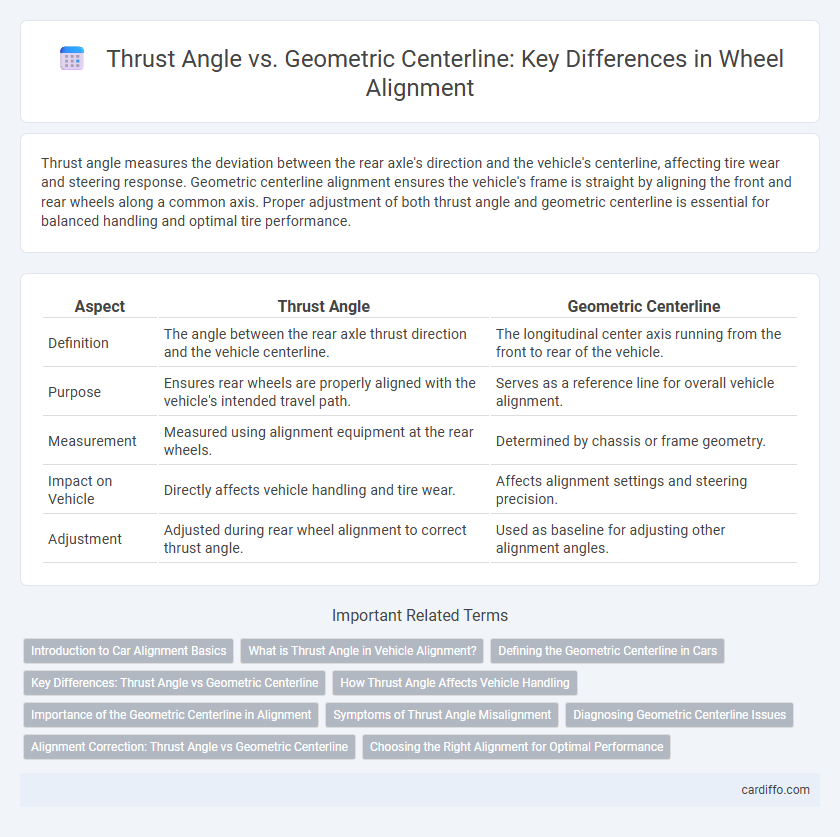Thrust angle measures the deviation between the rear axle's direction and the vehicle's centerline, affecting tire wear and steering response. Geometric centerline alignment ensures the vehicle's frame is straight by aligning the front and rear wheels along a common axis. Proper adjustment of both thrust angle and geometric centerline is essential for balanced handling and optimal tire performance.
Table of Comparison
| Aspect | Thrust Angle | Geometric Centerline |
|---|---|---|
| Definition | The angle between the rear axle thrust direction and the vehicle centerline. | The longitudinal center axis running from the front to rear of the vehicle. |
| Purpose | Ensures rear wheels are properly aligned with the vehicle's intended travel path. | Serves as a reference line for overall vehicle alignment. |
| Measurement | Measured using alignment equipment at the rear wheels. | Determined by chassis or frame geometry. |
| Impact on Vehicle | Directly affects vehicle handling and tire wear. | Affects alignment settings and steering precision. |
| Adjustment | Adjusted during rear wheel alignment to correct thrust angle. | Used as baseline for adjusting other alignment angles. |
Introduction to Car Alignment Basics
Thrust angle refers to the direction that the rear wheels point relative to the vehicle's geometric centerline, which is an imaginary line drawn down the exact center of the car from front to rear. Proper alignment requires the thrust angle to be as close to zero as possible to ensure the rear wheels track directly behind the front wheels, improving stability and tire wear. Misalignment of the thrust angle can cause the vehicle to pull or drift, negatively impacting handling and fuel efficiency.
What is Thrust Angle in Vehicle Alignment?
Thrust angle in vehicle alignment is the angle formed between the vehicle's geometric centerline and the direction that the rear wheels are pointing. It reflects the rear axle's alignment relative to the vehicle's centerline, affecting overall handling and tire wear. Proper thrust angle ensures the vehicle tracks straight and maintains stability during driving.
Defining the Geometric Centerline in Cars
The geometric centerline in cars is defined as an imaginary line that runs longitudinally through the exact midpoint of the vehicle's chassis or frame, serving as a reference for measuring alignment angles. This line ensures accurate assessment of thrust angle, which is the angle between the thrust vector of the rear wheels and the geometric centerline. Precise determination of the geometric centerline is crucial for optimizing vehicle stability, handling, and tire wear.
Key Differences: Thrust Angle vs Geometric Centerline
Thrust angle measures the deviation between the vehicle's thrust line and its geometric centerline, indicating wheel alignment discrepancies affecting straight travel. Geometric centerline is the midpoint running longitudinally between the vehicle's frame rails, serving as the baseline for alignment settings. Thrust angle misalignment causes uneven tire wear and steering issues, while geometric centerline remains a fixed reference for proper vehicle alignment.
How Thrust Angle Affects Vehicle Handling
Thrust angle, the angle between the vehicle's geometric centerline and the direction the rear wheels point, directly impacts vehicle handling by influencing tire wear and steering responsiveness. A misaligned thrust angle causes the vehicle to pull to one side, reducing stability and increasing the risk of uneven tire wear, which compromises safety and control. Correcting the thrust angle ensures proper wheel alignment, enhancing steering precision and overall driving performance.
Importance of the Geometric Centerline in Alignment
The geometric centerline serves as the fundamental reference axis in alignment, crucial for ensuring the precise positioning of rotating equipment. Accurate alignment based on the geometric centerline minimizes misalignment-induced vibration, bearing wear, and mechanical failure. Establishing the geometric centerline allows for correct thrust angle adjustments, maintaining operational efficiency and extending machinery lifespan.
Symptoms of Thrust Angle Misalignment
Thrust angle misalignment often causes uneven tire wear, particularly on the inside or outside edges, leading to rapid tread deterioration. Drivers may experience vehicle pulling to one side, requiring constant steering correction to maintain a straight path. Excessive vibration and increased steering effort are common symptoms, signaling improper alignment between the thrust angle and the geometric centerline.
Diagnosing Geometric Centerline Issues
Diagnosing geometric centerline issues requires comparing the thrust angle to the vehicle's intended alignment path, as misalignment can cause uneven tire wear and handling problems. Using specialized alignment tools, technicians measure deviations between the thrust angle and geometric centerline to identify rear-end alignment faults. Accurate assessment ensures corrective adjustments restore proper vehicle tracking and stability.
Alignment Correction: Thrust Angle vs Geometric Centerline
Thrust angle alignment correction ensures the rear wheels are parallel to the geometric centerline of the vehicle, preventing uneven tire wear and improving handling stability. Accurate measurement of the thrust angle relative to the geometric centerline helps technicians recalibrate suspension components, restoring proper wheel alignment. Maintaining a zero or minimal thrust angle relative to the centerline optimizes vehicle drivability and enhances overall safety during cornering and straight-line travel.
Choosing the Right Alignment for Optimal Performance
Selecting the correct thrust angle alignment relative to the geometric centerline is crucial for optimal vehicle performance and tire longevity. Misalignment can cause uneven tire wear, reduced fuel efficiency, and impaired handling, impacting overall safety and vehicle dynamics. Precise measurements using professional alignment tools ensure that the thrust angle is properly set to maintain stability and enhance driving comfort.
Thrust Angle vs Geometric Centerline Infographic

 cardiffo.com
cardiffo.com